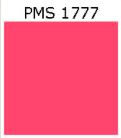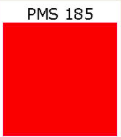If you’ve ever been to an acupuncturist, you’ve likely been quizzed extensively about the length, color, and consistency of your period. Why, you may wonder, are we so obsessed with your menstrual blood? Are we secretly vampires? Collecting research for Pantone’s color of the year?
The truth is, while various consistencies and shades of red are usually not pathological from a gynecological standpoint, they can indicate an abnormality in the balance of yin and yang in the body, which, if left untreated, could potentially lead to a pathological condition.
From a Chinese medicine perspective, an average cycle length should be between 28-35 days, with 3-5 days of moderate bleeding. Average flow should require the use of one regular pad or tampon about every 3-4 hours. According to Chinese medicine, cramps and PMS symptoms like headaches, bloating, and breast tenderness are abnormal and usually indicate stagnation.
So, what can we tell from the color of your flow? Below we have listed the 5 most common variations that we see at Yinova. For reference, we’ve included some Pantone color chips, which are ironically named PMS chips (Pantone Matching System).
 The ideal color should be crimson red, and the consistency should be pretty similar to what you’d see if you were bleeding from any other part of your body.
The ideal color should be crimson red, and the consistency should be pretty similar to what you’d see if you were bleeding from any other part of your body.
 Pale pink blood, especially with a watery consistency, indicates a deficiency, specifically of the spleen qi. In Chinese medicine, the spleen is analogous to the digestive system and is responsible for processing the food we eat to produce qi and blood. If the spleen is deficient, it can’t produce enough blood for a proper period, and you may experience symptoms like bloating, fatigue, and a feeling of heaviness or cramping in the legs around your period.
Pale pink blood, especially with a watery consistency, indicates a deficiency, specifically of the spleen qi. In Chinese medicine, the spleen is analogous to the digestive system and is responsible for processing the food we eat to produce qi and blood. If the spleen is deficient, it can’t produce enough blood for a proper period, and you may experience symptoms like bloating, fatigue, and a feeling of heaviness or cramping in the legs around your period.
 Dark red blood with clots indicates that there is liver qi stagnation. The liver system is responsible for regulating the flow of qi and blood throughout the body. Any interruption in the smooth flow of qi can lead to stagnation symptoms around the period, especially cramps, headaches, and breast pain. The liver is easily affected by stress so that you may notice an appearance or increase of these symptoms during any particularly stressful months.
Dark red blood with clots indicates that there is liver qi stagnation. The liver system is responsible for regulating the flow of qi and blood throughout the body. Any interruption in the smooth flow of qi can lead to stagnation symptoms around the period, especially cramps, headaches, and breast pain. The liver is easily affected by stress so that you may notice an appearance or increase of these symptoms during any particularly stressful months.
 Bright red blood that is thick, almost mucous-like, is usually an indication of heat (think inflammation). If this is accompanied by any other symptoms, including a fever, foul-smelling discharge, or severe pelvic pain, please see your doctor right away to ensure there isn’t a serious infection.
Bright red blood that is thick, almost mucous-like, is usually an indication of heat (think inflammation). If this is accompanied by any other symptoms, including a fever, foul-smelling discharge, or severe pelvic pain, please see your doctor right away to ensure there isn’t a serious infection.
 Blood with a more purple tone and with large clots tells us that there is blood stasis. If stagnation persists over a long period of time, it can lead to what Chinese medicine terms “blood stasis,” which usually presents as very dark, almost purplish blood with large clots. This can include conditions like endometriosis and fibroids and usually involves very intense, sharp, stabbing cramps and heavy flow.
Blood with a more purple tone and with large clots tells us that there is blood stasis. If stagnation persists over a long period of time, it can lead to what Chinese medicine terms “blood stasis,” which usually presents as very dark, almost purplish blood with large clots. This can include conditions like endometriosis and fibroids and usually involves very intense, sharp, stabbing cramps and heavy flow.
If you experience any of these symptoms, Chinese medicine can be especially effective at providing relief. Sometimes treatment requires 3-6 months of weekly acupuncture and herbs, and sometimes it’s as simple as a heating pad and not giving in to those ice cream cravings around your period. See an acupuncturist for an evaluation to determine exactly what your period color indicates and how Chinese medicine can help.



